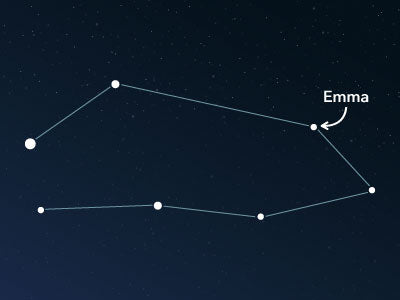The constellation Piscis Austrinus
Caratteristiche
- Nome latino
- Piscis Austrinus
- Emisfero
- Emisfero meridionale
- Visibilità
- July - September
- Area
- 245 deg²
- Stella più luminosa
- Formalhaut (HIP number 113368)
- Specialità
- Galaxies

The Piscis Austrinus, Latin for Southern Fish, is an inconspicuous constellation in the southern celestial sky with a particularly noticeable star. It is one of the 48 ancient constellations defined by the Greco-Roman astronomer Claudius Ptolemy. There are only a few deep-sky objects in this area of the sky.
Hemisphere, visibility, and area
The Piscis Austrinus constellation can be observed from the entire southern hemisphere. North of the equator, it is fully visible up to the 54th parallel. This corresponds to regions such as Hamburg in Germany or Edmonton in Canada.
The best time to observe the constellation is from July to September. It covers an area of about 245 square degrees of the night sky, ranking 60th out of all 88 constellations.
The constellation is rather unremarkable, as it contains primarily faint stars. Only one star stands out. It bears the proper name Fomalhaut (Latin: α Piscis Austrini, Alpha Piscis Austrini). The name comes from the Arabic word "Fum al Hut," which means "mouth of the fish." Accordingly, in visualizations, the star Fomalhaut always represents the head of a fish. It has an apparent magnitude of roughly 1.2 and is one of the 20 brightest stars in the entire night sky.
To find the Piscis Austrinus in the night sky, it can be helpful to orient oneself on adjacent constellations. To the north are the constellations Aquarius and Capricornus, which are particularly well-known in astrology. To the east is Microscopium, to the west is Sculptor, and to the south is Grus.
Specialties in the constellation
The constellation Piscis Austrinus does not offer any nebula objects that are visible to the naked eye. However, with the help of professional equipment, a barred spiral galaxy can be observed.
This galaxy is cataloged as NGC 7314 or Arp 14 and was discovered by the German-British astronomer William Herschel in July 1834. Its distance from the Milky Way is estimated to be around 66 million light-years.
History and mythology
The constellation Piscis Austrinus is one of the oldest star patterns, as it was already determined before Greek antiquity. When, for example, the constellation Pisces was defined, the Piscis Austrinus already existed. Nevertheless, Claudius Ptolemy included it in the list of the 48 constellations of antiquity.
The origin goes back to the Babylonian fertility god Oannes, who was described as a man with a fishtail and was highly revered more than 3,500 years ago.
Evidence of this occurrence is provided by figures of a fish god found in Assur and Nineveh (today Iraq). In addition, the Philistines also worshiped a fertility god with a fishtail about 800 years later. He was called Dagon and lived in a magnificent temple. However, according to the Bible, it was destroyed by Samson, a biblical figure and one of the judges of the Israelites.
PubblicatoLeggi altri articoli interessanti

An overview of all 88 constellations
Learn more about all 88 constellations and read interesting information about the mythology, visibility, and features.

App Planetario
Discover the night sky with our planetarium app!
Available for iOS and Android.

Dai un nome a una stella nella costellazione Southern Fisch
Name a star in a constellation and create something that lasts for eternity.